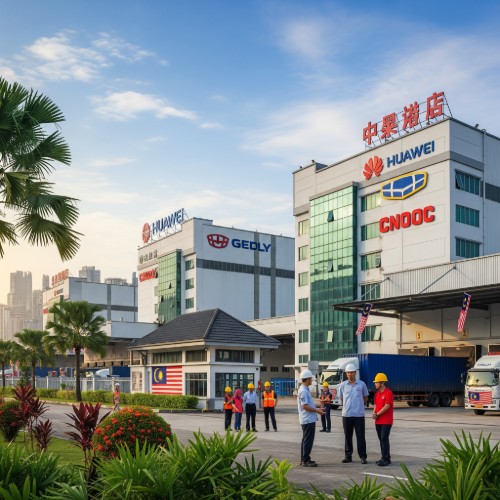Chinese investment Malaysia 2025
Malaysia is once again in the spotlight for foreign investors, and this time, it’s not just about palm oil, manufacturing, or tourism. A significant wave of Chinese investment is heading towards Malaysia, signalling potential shifts in the country’s economic landscape and its positioning within the ASEAN region. Here’s what you need to know.
Who’s Investing?
According to recent reports, around 100 Chinese companies are eyeing Malaysia for expansion. That’s not a typo. One hundred. This fresh influx of Foreign Direct Investment (FDI) demonstrates growing confidence in Malaysia as a strategic hub for high-tech and advanced industries.
What Sectors Are They Targeting?
- Artificial Intelligence (AI)
Think smart city technologies, machine learning, and automation for manufacturing. For example, Chinese AI firms specialising in facial recognition and logistics optimisation are exploring Southeast Asia as the next growth market (South China Morning Post, 2025). - Semiconductors
As the US-China tech rivalry heats up, many Chinese semiconductor companies are seeking alternative hubs. Malaysia’s strong semiconductor ecosystem – with giants like Infineon and Intel in Penang – makes it a natural fit. - Biomedical Industries
From vaccine research startups to biotech equipment manufacturers, Chinese biomedical firms are eyeing Malaysia’s BioNexus incentives and strategic ASEAN location.
Additionally, sectors such as renewable energy and green technology are beginning to attract Chinese attention. Solar panel manufacturers, battery storage solution providers, and electric vehicle ecosystem companies have reportedly initiated early-stage talks with Malaysian agencies. This aligns with Malaysia’s push for sustainability under its National Energy Transition Roadmap 2050, which aims to position the country as a regional leader in clean energy innovation.
When Did This Happen?
This surge of interest isn’t random. In June 2025, Malaysia hosted the China-Malaysia High-Level Economic Forum in Kuala Lumpur. Attended by top government officials and business leaders, the event set the tone for upcoming mega deals (The Edge Malaysia, June 2025).
Where Will These Investments Land?
While Kuala Lumpur remains Malaysia’s financial hub, Penang and Johor are front-runners for tech investments.
- Penang – Dubbed the “Silicon Valley of the East” for its semiconductor facilities and engineering talent.
- Johor – Its proximity to Singapore makes it a manufacturing and logistics sweet spot.
Beyond these, the East Coast Economic Region (ECER) is quietly emerging as a new destination for industrial parks catering to high-value manufacturing. Recent initiatives in Pahang and Terengganu focus on creating integrated industrial clusters to attract investments in petrochemicals, biotech, and advanced material sciences.
How Will This Impact Malaysia?
If even half of these companies follow through, Malaysia can expect:
- Job creation in high-tech sectors (semiconductor engineers, AI data analysts, biotech researchers)
- Technology transfer and upskilling to boost competitiveness in advanced manufacturing
- Diversified FDI portfolio beyond oil & gas into future-proof industries
Moreover, these investments will enhance Malaysia’s position in global supply chains. As Chinese firms establish regional headquarters and research centres locally, local SMEs stand to benefit through supplier contracts, knowledge sharing, and potential joint ventures. Economists have long emphasised that sustainable FDI isn’t just about capital inflow but also about integrating local firms into international production networks.
Why Now?
Two reasons:
- Geopolitical Shifts – The China-US rivalry has Chinese firms seeking stable, friendly investment destinations within ASEAN.
- Malaysia’s Positioning – With the New Industrial Master Plan 2030, Malaysia is cementing itself as a regional high-tech manufacturing and digital economy hub.
“We see Malaysia as a natural extension of our Southeast Asia strategy, offering both a stable environment and an advanced tech ecosystem,” said Lin Wei, Director of Business Expansion at a Shenzhen-based AI firm during the KL forum in June.
Are There Any Risks?
While optimism is high, analysts caution that Malaysia must manage foreign investment carefully to avoid over-reliance on a single country. There are also concerns over environmental sustainability, data security in AI sectors, and ensuring that local talent is upskilled sufficiently to fill specialised roles created by these firms.
Final Thoughts
In summary, Malaysia’s strategic geographical location, strong manufacturing ecosystem, and forward-looking economic policies are positioning it as a natural magnet for Chinese investments. As Chinese companies diversify beyond domestic and traditional Western markets, Malaysia stands to benefit significantly in terms of job creation, technological advancement, and regional competitiveness.
However, the real question remains: Is Malaysia ready to harness and sustain this wave of smart money for long-term growth?
Ringkasan dalam Bahasa Malaysia
Lebih 100 syarikat China merancang pelaburan dalam AI, semikonduktor, bioteknologi, dan tenaga boleh diperbaharui di Malaysia menjelang 2025.
中文摘要
超过100家中国公司计划于2025年在马来西亚投资人工智能、半导体、生物技术以及可再生能源领域。


